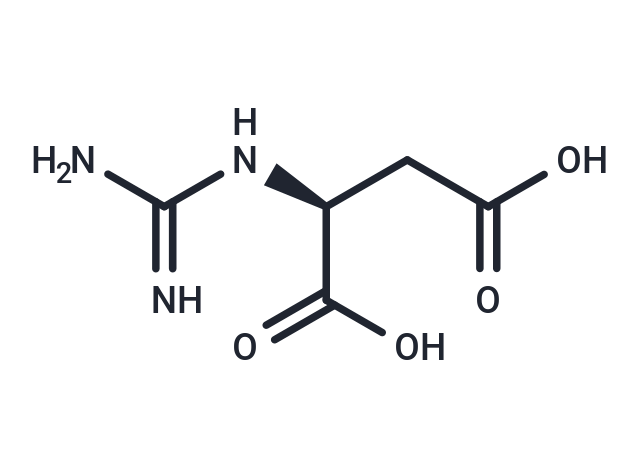Shopping Cart
Remove All Your shopping cart is currently empty
Your shopping cart is currently empty
Guanidinosuccinic acid (GSA) has been identified as a uremic toxin, is a nitrogenous metabolite isolated in excess from serum and urine.

| Pack Size | Price | USA Warehouse | Global Warehouse | Quantity |
|---|---|---|---|---|
| 25 mg | $35 | In Stock | In Stock | |
| 50 mg | $48 | - | In Stock | |
| 100 mg | $85 | - | In Stock | |
| 1 mL x 10 mM (in DMSO) | $29 | In Stock | In Stock |
| Description | Guanidinosuccinic acid (GSA) has been identified as a uremic toxin, is a nitrogenous metabolite isolated in excess from serum and urine. |
| In vivo | Guanidinosuccinic acid (GSA), a guanidino compound found to be greatly increased in uremia, was administered by intraperitoneal (i.p.) injection to adult albino mice and to young mice 7, 14 and 21 days old.?Epileptogenic and toxic properties were assessed and GSA brain levels following i.p. injection were determined.?In adult mice, GSA induced long-lasting generalized clonic and clonic-tonic convulsions in a dose-dependent manner with a CD50 (and 95% confidence interval) of 363 (287-458) mg/kg (n = 35), and an LD50 of 579 (445-756) mg/kg.?The CD50 of GSA corresponded with a brain concentration of 56 nmol/g tissue.?Electrocorticographic recording in five adult mice revealed epileptiform discharges (spikes, spike-waves, and polyspike-waves) which appeared concomitant with the convulsions.?When young mice were i.p. injected with a (for adults) subconvulsive dose of GSA (250 mg/kg), an age-dependent decrease was noted in GSA-induced convulsions and in the resulting brain concentration[1]. |
| Molecular Weight | 175.14 |
| Formula | C5H9N3O4 |
| Cas No. | 6133-30-8 |
| Smiles | NC(=N)N[C@@H](CC(O)=O)C(O)=O |
| Relative Density. | 1.74g/cm3 |
| Color | White |
| Appearance | Solid |
| Storage | Powder: -20°C for 3 years | In solvent: -80°C for 1 year | Shipping with blue ice/Shipping at ambient temperature. | |||||||||||||||||||||||||||||||||||
| Solubility Information | H2O: 6 mg/mL (34.26 mM), Sonication is recommended. DMSO: 15.63 mg/mL (89.24 mM), Sonication is recommended. | |||||||||||||||||||||||||||||||||||
Solution Preparation Table | ||||||||||||||||||||||||||||||||||||
H2O/DMSO
DMSO
| ||||||||||||||||||||||||||||||||||||
| Size | Quantity | Unit Price | Amount | Operation |
|---|

Copyright © 2015-2025 TargetMol Chemicals Inc. All Rights Reserved.